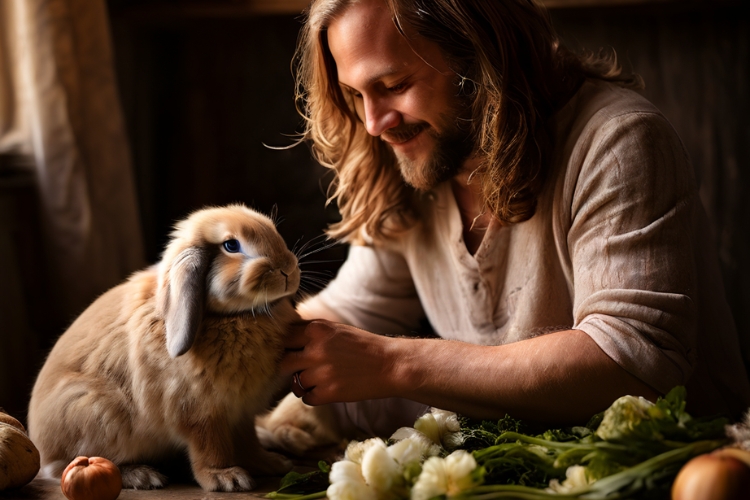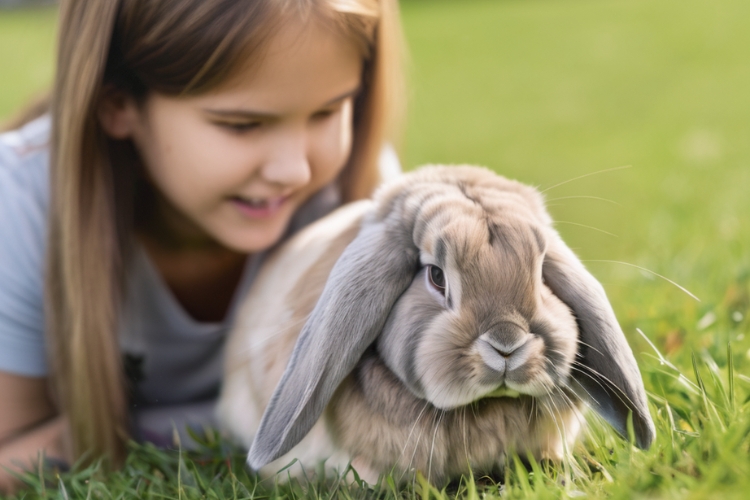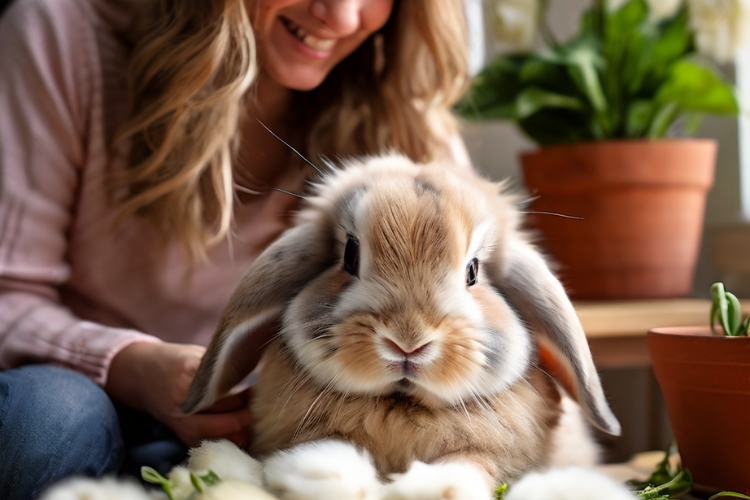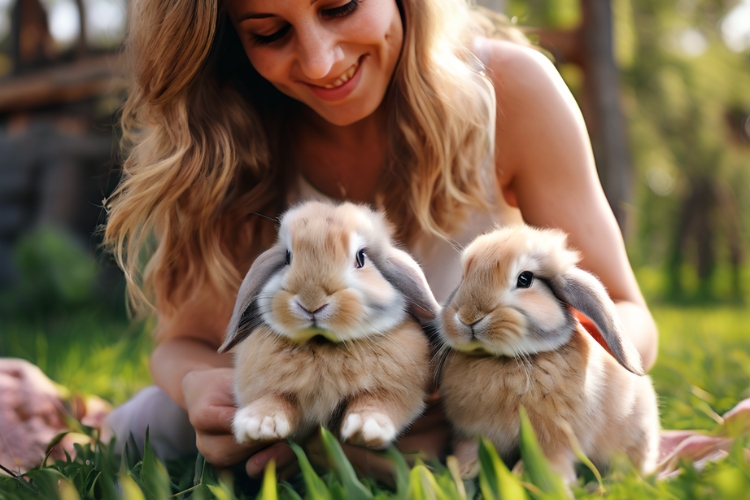When it comes to choosing a family pet, rabbits often top the list for their adorable appearance, gentle nature, and relatively low-maintenance care.
Among the various rabbit breeds, the Holland Lop stands out as a popular choice for households with children. But is this breed truly a good fit for families?
In this blog post guide, we’ll explore the traits, care requirements, and suitability of the Holland Lop as a family pet.
Understanding the Holland Lop Breed
The Holland Lop is a breed of domestic rabbit known for its distinctive small stature and floppy ears. Originating in the Netherlands, these rabbits were developed in the 1950s by crossing the French Lop with the Netherland Dwarf.
The result was a compact, rounded body and a unique appearance that quickly gained popularity among rabbit enthusiasts.
Key Characteristics of the Holland Lop
- Size: Holland Lops are considered a dwarf breed, typically weighing between 2 and 4 pounds when fully grown.
- Appearance: Their most distinctive feature is their floppy ears that drape close to their head, coupled with a compact, rounded body shape.
- Coat: Holland Lops come in a variety of colors, including solid hues like black, white, and chocolate, as well as broken patterns like tortoiseshell and harlequin.
- Temperament: Known for their gentle, calm, and affectionate nature, Holland Lops are often described as good-natured and adaptable.
Holland Lops as Family Pets
When considering a pet for a family environment, several factors come into play, including the animal’s temperament, care requirements, and compatibility with children. Here’s how the Holland Lop measures up:
Pros of Holland Lops as Family Pets
- Gentle Nature: The Holland Lop’s calm and affectionate demeanor makes them well-suited for interaction with children when properly supervised and handled.
- Small Size: Their compact size and relatively low activity levels make them easier to manage and less likely to accidentally knock over or overwhelm small children.
- Minimal Grooming Needs: With a short, dense coat, Holland Lops require minimal grooming, which can be a plus for busy families.
- Adaptability: Holland Lops are known for their ability to adapt well to various living situations, including apartment or indoor settings.
Considerations for Holland Lops as Family Pets
- Supervision Required: Like any pet, Holland Lops should never be left unsupervised with young children to prevent accidental injuries or stress to the animal.
- Proper Handling: Children must be taught how to properly handle and interact with rabbits to avoid frightening or hurting the animal.
- Noise and Activity Levels: While generally calm, Holland Lops may become startled by loud noises or excessive activity, which can be challenging in households with boisterous children.
- Chewing Habits: Rabbits are known for their chewing tendencies, so families must be prepared to provide appropriate chew toys and protect household items from potential damage.
Caring for a Holland Lop in a Family Setting
Responsible pet ownership is crucial for ensuring the well-being of both the animal and the family. Here are some essential care considerations for keeping a Holland Lop as a family pet:
Housing and Environment
- Spacious Enclosure: While Holland Lops are a smaller breed, they still require a spacious enclosure or rabbit-proofed area with ample room to move around and exercise.
- Appropriate Bedding: Provide a suitable bedding material, such as aspen shavings or paper-based litters, to ensure comfort and cleanliness.
- Temperature Control: Rabbits are sensitive to extreme temperatures, so their living area should be kept cool in the summer and warm in the winter.
- Hiding Spots: Offer hiding spots or enclosed spaces where the rabbit can retreat and feel secure when desired.
Diet and Nutrition
- High-Quality Hay: Provide unlimited access to fresh, high-quality hay, such as timothy or orchard grass, which is essential for proper digestion and dental health.
- Balanced Diet: Supplement the hay with a small portion of fresh vegetables and a limited amount of rabbit-specific pellets for a balanced diet.
- Fresh Water: Ensure a constant supply of fresh, clean water to prevent dehydration.
Exercise and Enrichment
- Supervised Playtime: Allow the Holland Lop to have supervised playtime outside of its enclosure for exercise and mental stimulation.
- Rabbit-Proofing: Ensure the play area is free of potential hazards, such as exposed wires, toxic plants, or small spaces where the rabbit could become trapped.
- Toys and Enrichment: Provide appropriate chew toys, tunnels, and hiding spots to encourage natural behaviors and prevent boredom.
Grooming and Health
- Regular Brushing: While their coat is relatively low-maintenance, Holland Lops still benefit from regular brushing to remove loose hair and prevent hairballs.
- Nail Trimming: Trim the rabbit’s nails regularly to prevent overgrowth and potential injury.
- Veterinary Care: Schedule regular check-ups with an experienced rabbit veterinarian to monitor the animal’s health and address any potential issues.
Training and Socialization
- Litter Training: With patience and consistency, Holland Lops can be litter-trained, making them a cleaner and more convenient house pet.
- Positive Reinforcement: Use positive reinforcement techniques, such as treats and praise, to encourage desirable behaviors and build a bond with the rabbit.
- Socialization: Introduce the rabbit to family members gradually and supervise interactions to help them become comfortable and well-adjusted.
Tips for Introducing a Holland Lop to a Family
Bringing a new pet into a household can be an exciting but potentially stressful experience for both the animal and the family. Here are some tips to ensure a smooth transition:
- Prepare the Environment: Set up the rabbit’s enclosure and living area before bringing them home, ensuring it is safe, comfortable, and enriching.
- Gradual Introduction: Introduce the rabbit to family members gradually, starting with quieter interactions and working up to more active playtime.
- Supervise Interactions: Always supervise interactions between the rabbit and children, ensuring gentle handling and preventing accidental injuries or stress to the animal.
- Establish Rules: Set clear rules and expectations for how family members should interact with the rabbit, such as no chasing, loud noises, or rough handling.
- Involve Children in Care: Encourage children to participate in age-appropriate care tasks, such as filling food and water dishes or cleaning the enclosure, to foster a sense of responsibility and bonding with the pet.
Considering Alternatives: Other Family-Friendly Rabbit Breeds
While the Holland Lop is a popular choice, it’s worth considering other rabbit breeds that may be equally suitable for families. Here are a few alternatives to explore:
| Breed | Size | Temperament | Grooming Needs |
|---|---|---|---|
| Netherland Dwarf | Small (2-3 lbs) | Energetic, curious | Minimal |
| Mini Lop | Small (3-6 lbs) | Gentle, social | Moderate |
| Himalayan | Small (2-4 lbs) | Calm, easy-going | Moderate |
| Lionhead | Small (3-4 lbs) | Friendly, affectionate | High |
Remember, every rabbit has its own unique personality, and proper care, socialization, and supervision are essential for ensuring a successful pet-owner relationship, regardless of breed.
Conclusion
The Holland Lop can indeed make an excellent family pet, provided that their needs are met, and interactions are properly supervised and guided. With their gentle nature, compact size, and relatively low-maintenance grooming requirements, these rabbits can be a delightful addition to households with children.
However, it’s crucial to remember that rabbits are complex creatures with specific care requirements and should never be treated as mere toys or impulse purchases. Responsible pet ownership, patience, and a commitment to providing a safe and enriching environment are key to ensuring the well-being of both the rabbit and the family.
By carefully considering the pros and cons, as well as the individual needs and circumstances of your household, you can make an informed decision about whether the Holland Lop, or another rabbit breed, is the right fit for your family.





